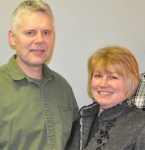by Rollie Hodgman, ‘NLs’ editor

Ivan Harper
A year ago we began this series on NCEM’s 5-Stage Church Multiplying strategy. We’ve attempted to explain the significance of each stage, and illustrate each with real people and places.
As the text in the yellow boxes on these pages indicates, there is more than one aspect to this stage. The most dramatic, though, is that this is when the missionary leaves.
Yes, that is what is supposed to happen! Our Mission’s vision is to establish indigenous churches – churches that are representative of the local community, suited to the culture and led by local Christians. These are churches that no longer rely on the church-planting missionary team.

Kelly Naytowhow
But let’s be honest. Leaving is never easy. The missionary team has invested much time and energy to establishing the church. More than that, they’ve given their hearts to these people.
And leaving may not be any easier for those left behind. There will be local believers who have never walked the Christian life or been part of the fellowship without the missionaries there.
More Than A Theory
We wanted these five articles to be as “un-theoretical-sounding” as possible. For this writer, Stage 5 definitely isn’t just mission theory. Three years ago our family exited from our direct involvement with New Life Indian Alliance Fellowship in Prince Albert (SK).
By way of background, NLIAF began as an outreach of Prince Albert Alliance Church in the late 1980s, with Ray Gallagher (C&MA) involved prior. Bob & Mary Thiessen served for awhile, followed by Leo & Leona Thiessen, who were key full-time NLIAF church planters for several years.

Blaine & Rachel Witherow
With NCEM’s Headquarters located in Prince Albert, it seemed natural that Mission staff would get involved at NLIAF. Several have for periods of time, with the Witherows and our family staying longer term. We’ve never considered ourselves “the” church planters – we have responsibilities at NCEM Headquarters (though my wife, Denise, has focused on personal ministries and, therefore, more closely tied to NLIAF) – but we were part of the church planting team.

Rollie & Denise Hodgman
With God’s blessing, the Fellowship grew and became an organized church with an elders board. In 1995 the Thiessens moved on, but the Native leaders wanted our two families to stay. We served through training and discipling, children’s and youth ministry, music, home visitation, and were generally part of Fellowship life – everything from taking our turn cleaning the building, to tithing, to birthday parties in homes.
Over the next decade, there were three pastors who served the Fellowship full-time. Then Ivan (& Sophia) Harper, originally from Onion Lake First Nation – but who had been discipled through NLIAF and had left for Bible college – moved back to become pastor in 2006.
As missionary workers, we sought to keep open communication with the Native leaders about our roles, and when it might be our time to move on.
Stage 5: Multiplying
- Referred to as “phase-out,” in this transitional stage the missionaries begin planned absences until the entire team is withdrawn physically. Relationships are maintained with return visits. By faith, at this stage we see a healthy indigenous multiplying community of faith!
- Key Scripture: Philippians 2:12: Therefore, my dear friends, as you have always obeyed – not only in my presence, but now much more in my absence – continue to work out your salvation…”
- Role of the church planter: learner, itinerant advisor, absent advisor.
- Role of community church: teachers, evangelists, disciplers, leaders, pastor/elders, church planters, administrators.
Stage 5: Objectives
Withdrawing in a manner that will leave the new church feeling empowered by the Holy Spirit, rather than feeling abandoned by the church planting team
- Facilitating the development of the local church’s own mission ministry
- Securing new part-time ministry for the church planter
- Establishing some means to maintain relationships in absentia.
Why Leave?
Sharing his perspective on “Stage 5” and our leaving NLIAF, Ivan Harper recently shared these thoughts for our readers:
“It was hard … no doubt about that. Of course we’d still like to be worshiping and singing and fellowshiping together on a regular basis. That is a beautiful thing, and it’s what we’ll do for eternity.
“To keep it all in perspective, though, this wasn’t my idea, nor the Mission’s idea, nor someone else’s strategy. There’s a biblical basis for leaving. In the New Testament we read of Paul and others appointing and training leaders, and then physically moving on.
“When we’re in the midst of ministry, we don’t always see the benefits of [the missionary team leaving]. But when you look at the whole picture, I believe the bottom line is that for real maturity to take place … to really grow … there has to be autonomy, even within the Body of Christ. In church planting there has to come a point where the Native church takes responsibility.
“Even if it means making mistakes, we need to own our decisions. I don’t think missionaries always know how really deep that need is.
“After the leaving, we desire for our relationships with missionaries to continue. In fact, I think our relationships can deepen and we are more truly partners then. Up till then it might not always feel that way. If the bottom line is the work of God in our lives, and our relationship in the Body, then leaving causes all of us to grow.”
It’s Different Now
Kelly Naytowhow was a student at Key-Way-Tin Bible Institute when the Witherows and Hodgmans exited NLIAF.
It was different when I got back,” says Kelly, who is now an associate pastor at NLIAF. “I noticed that people had to pick up jobs. One of the first things I had to do was organize a group and rides to a youth retreat, and figure out how to pay for it.
“At first it’s hard to do something new. But it’s a good thing. It creates an opportunity for the Native believers to take initiative and lead. The missionaries gave good examples, but it’s our turn now.”
Real Responsibility
“I see the missionary’s role is to get things started, and raise up believers,” adds Kelly. “By the time the missionaries leave, the believers have seen how a church should be, and take on responsibility for themselves.”
NCEMer Conrad Flett, who mentors Native church leaders in several places, and who is also involved at NLIAF, concurs. He’s seen Native believers given responsibility in the church. “But when the missionary is absent, then it’s really their responsibility,” he says. “If they don’t do the work, they know it won’t get done.”
Multiplying Communities of Faith
Through NCEM’s ministry over the years we praise the Lord for each community where “Stage 5” has taken place. There are many more places where it still needs to happen.
Each setting has its unique history and circumstances. (For instance, the planting of NLIAF is not typical in that we missionaries continue to live in the same community because of our roles at NCEM Headquarters.)
What is similar to all is that, just as Stage 1, 2, 3 & 4 require the Holy Spirit’s power through prayer, plus our efforts, so does Stage 5. Satan will try to hinder the planting of Christ’s Church while the missionary team is present, while we’re leaving, and he won’t stop after we’ve left. I heard a pastor say recently: Satan will use one or all of the “three Ds”: distraction, disunity, and discouragement. But Christ has promised to build His Church (Matt. 16).
In NCEM we have workers at each of the five stages, and we’re looking for fresh new missionary teams excited about launching out from Stage 1. We desire to keep our eyes on the Lord and the goal: healthy indigenous multiplying communities of faith: churches that will in turn plant churches.

(from Northern Lights Issue #521). Note: some of the locations and involvements of our missionaries may have changed since the original publishing of this article.

